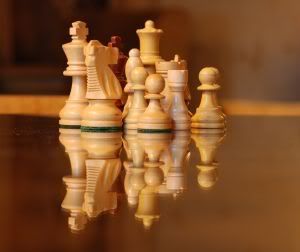Balance in Games
 One of my passions is games. Whether it is board games, video games, card games, role-playing games, or miniature games I truly enjoy playing them. Part of the reason is that it challenges my brain and I enjoy figuring out new things. My wife used to chuckle at me when I would be reading sometimes very lengthy rulebooks for entertainment. Along the way I became a game designer, writing books and articles creating new games or adding to existing ones. One of the interesting concepts of game design is the idea of game balance. That is each side needs an equal chance to win the game. I find that I’m often applying the concept of game balance to my real world life as well.
One of my passions is games. Whether it is board games, video games, card games, role-playing games, or miniature games I truly enjoy playing them. Part of the reason is that it challenges my brain and I enjoy figuring out new things. My wife used to chuckle at me when I would be reading sometimes very lengthy rulebooks for entertainment. Along the way I became a game designer, writing books and articles creating new games or adding to existing ones. One of the interesting concepts of game design is the idea of game balance. That is each side needs an equal chance to win the game. I find that I’m often applying the concept of game balance to my real world life as well.
Sometimes game balance is a very easy thing to achieve. Look at chess. Each player has the same pieces and the same rules. Arguably the white player may have a slight advantage since they get to move first, however that is typically mitigated by random choice or playing two games, switching sides. Other games become a little more challenging. For instance look at a game called Axis and Allies. It recreates World War II with each player controlling one of the Axis or Allie countries. Each country is not inherently equal to each other country. They have their own advantages and disadvantages. Ideally when taken as a whole, the three Ally countries should have as much chance of winning as the two Axis countries. The game designer addressed this by forcing the countries to go in certain order each turn and with other, country specific decisions.
So you can see that game balance can be a tricky thing to accomplish. The more complex the game is, the more likely it is to be unbalanced. Using the Axis and Allies example, there is a significant number of people who feel the game is easier to win if you play on the Ally side vs. the Axis side. Given the numerous decisions made on each turn and the different skill levels of the players, along with the random results of the dice, true balance can never be reached. Instead, a game designer simply hopes to eliminate most of the obvious imbalances and leave the rest to be overcome via player skill and randomness.
But how are these imbalances removed? Typically it is done through a process called play testing. In essence, the game designer sends the game to groups of people who then play it and give their opinions on what works well and what does not work. These comments are sent back to the designer, they make some changes to the game and send it back out for play testing. Often the final produced version of a game is radically different than the designer’s initial one because of these changes.
So how to apply this to life? During play testing, an undesirable outcome is noticed and the rules are changed and the game is played again. In life, it is important to notice potential undesirable outcomes before they happen. If you notice one of these, then make some changes to the “rules” in your life. An easy example is perhaps you realize that your tax burden will increase significantly this year. You will need to make an adjustment early to store the appropriate amount of money away so you aren’t hit by a surprise come April 15th next year.
The important thing here is to notice potential undesirable outcomes before they happen. To do this, you need to pay attention to what is going on around you, not just make through day-to-day. It takes a longer-term view of your life, from a few months to a year or more, and making the minute “rules” adjustments to smooth out the impacts from bad things that happen. While you can never truly be prepared for everything, you can certainly mitigate what happens to you in most cases. This puts you in control of your own life and master of your own fate.
So look around you and think about the rest of the year. Are there any potential traps lurking in the horizon? It is time to change a rule or two in your rulebook?
Posted: July 7th, 2008 under Balance.
Comments: none